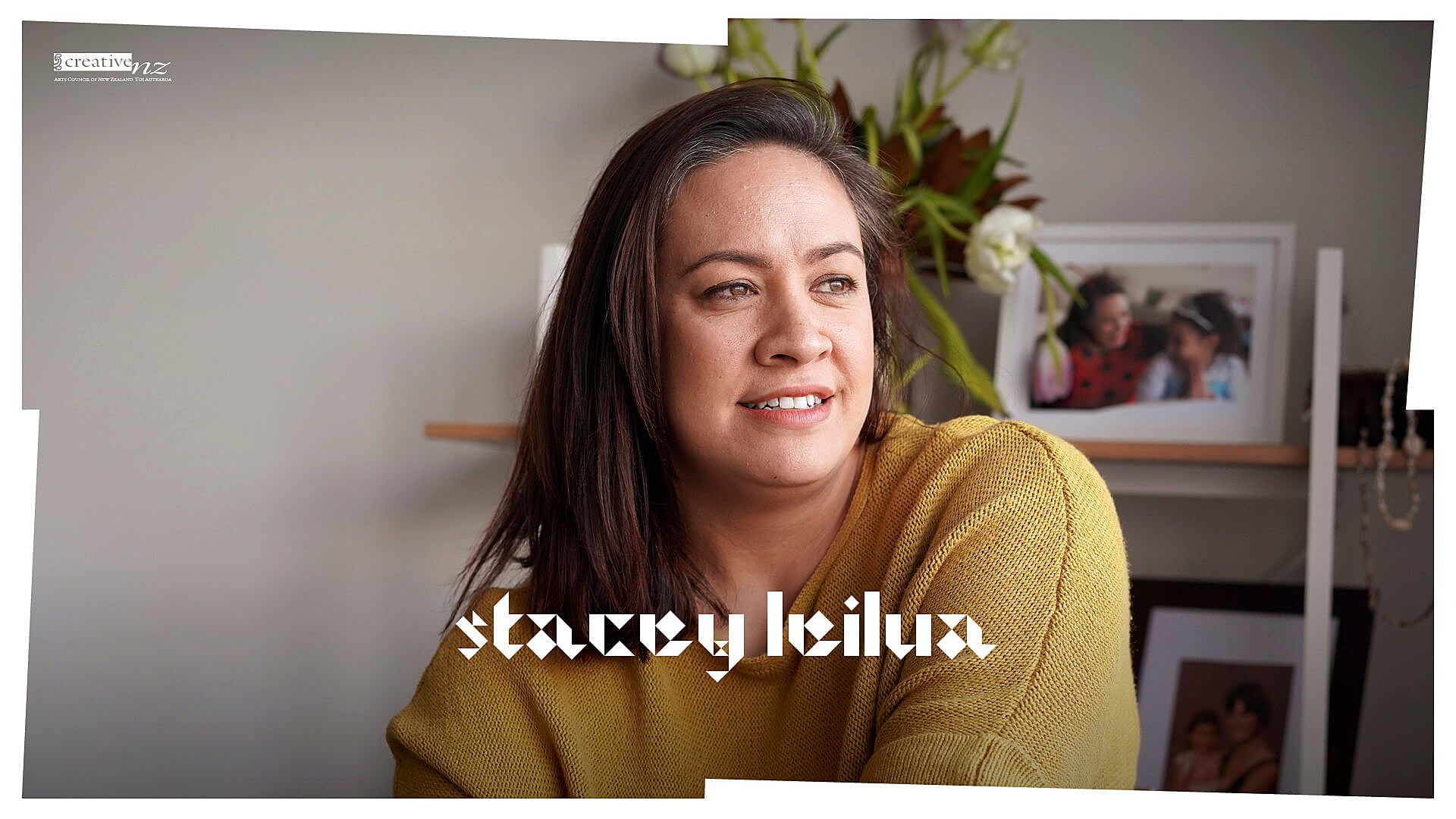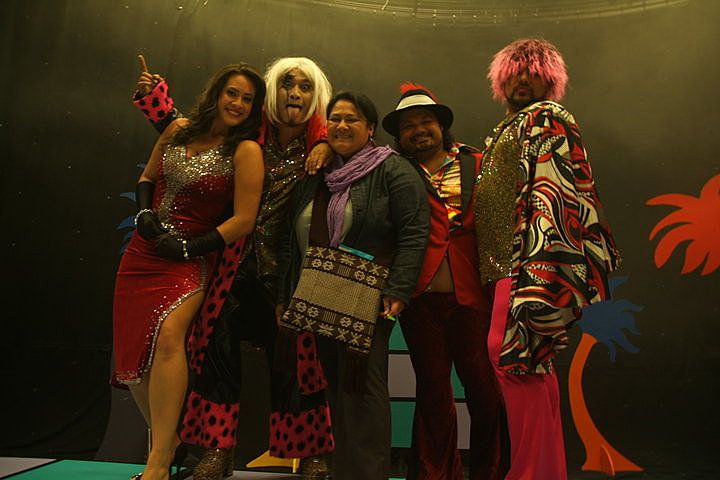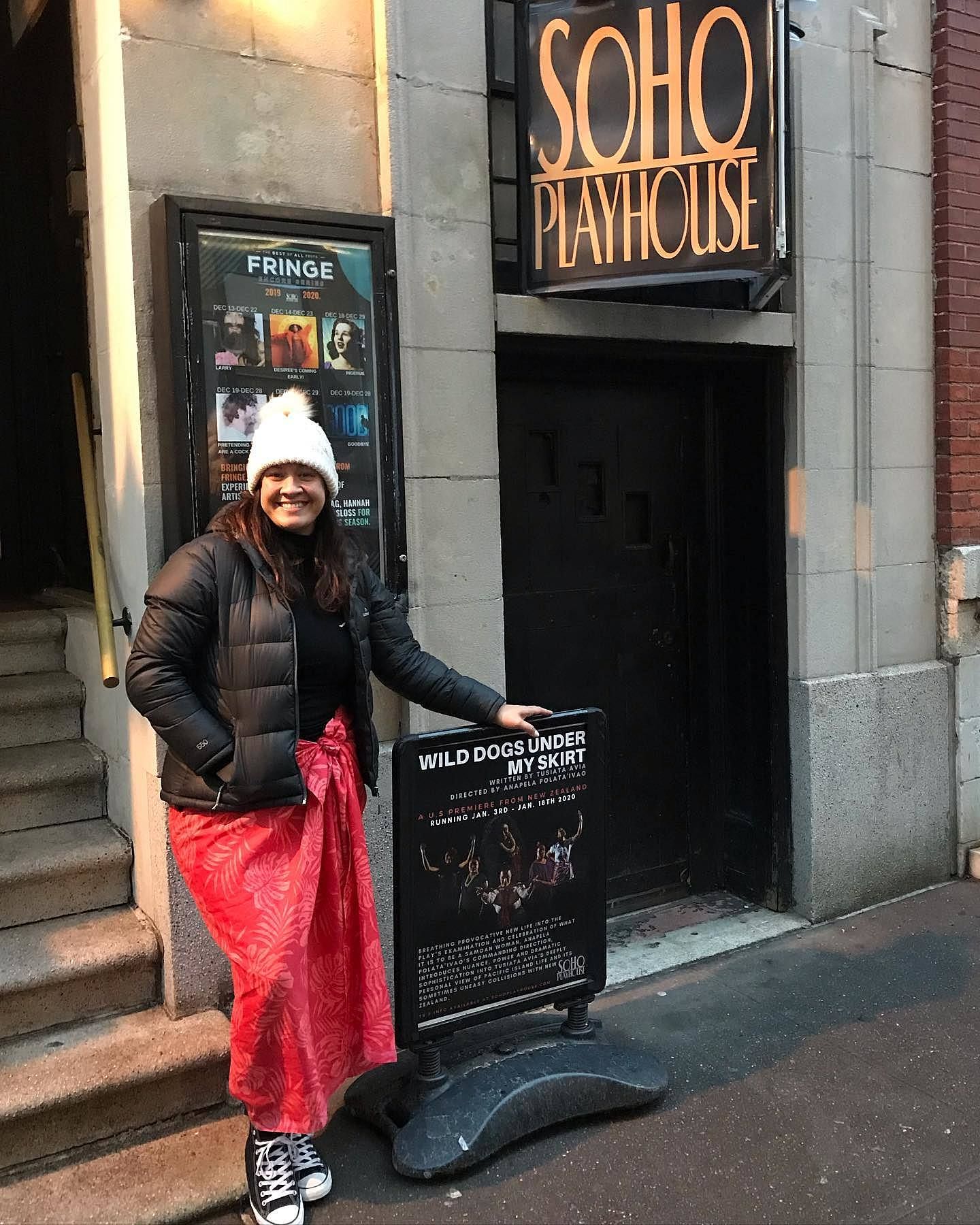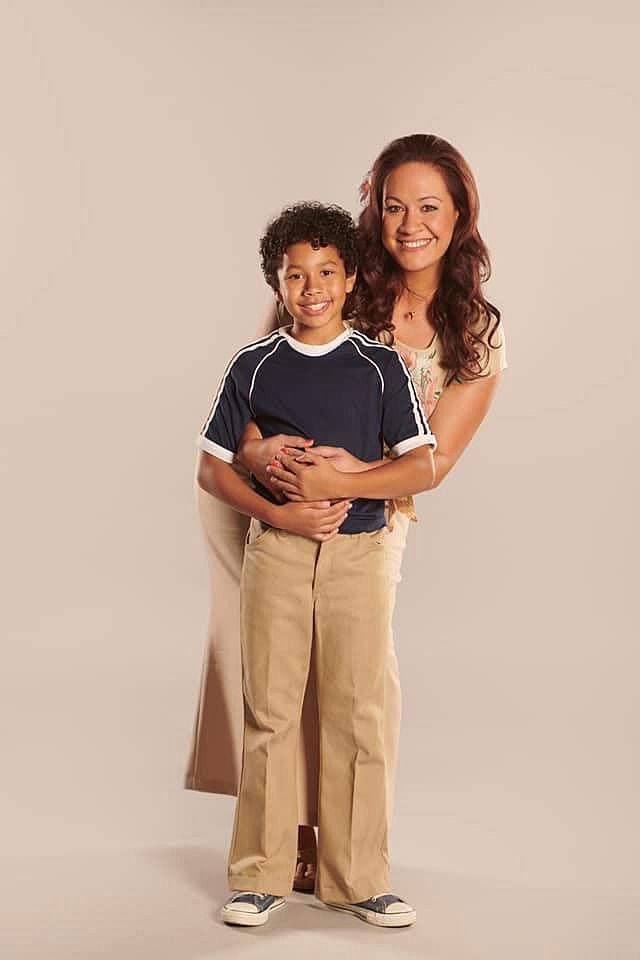When Time Stops
From a shy ten-year-old unable to answer a question about her heritage, to being a part of landmark Pacific representations on stage and screen, actress Stacey Leilua writes about her journey and the things no one sees.
We’re collaborating with Creative New Zealand to bring you the groundbreaking Pacific Arts Legacy Project. Curated by Lana Lopesi as project Editor-in-Chief, it’s a foundational history of Pacific arts in Aotearoa as told from the perspective of the artists who were there.
The beginning
Darkness. It is the opening night of Wild Dogs Under My Skirt at the Soho Playhouse. I’m backstage with the rest of my Wild Maile – it’s January 2020, the middle of winter in pre-Covid New York City. The concrete floor is freezing under my bare feet, I’m jumping on the spot, rotating my ankles and knees, which are all slathered in deep heat. In character as Tusiata Avia (poet, High Doggess and writer of the show), I open the performance space with a siva Sāmoa, and the thought of my almost-40-year-old limbs not being able to support me gracefully only adds to the insecurities I feel about performing a siva in the first place. I remind myself of the words that others have told me, which help to allay my fears and boost my confidence every time: dance for your ancestors. They are out there, watching with pride and cheering you on. I take a moment, close my eyes and remember. Honour the journey. The many sacrifices. The sound of American voices in the audience starts to subside as the dogs enter the space. I move to the wings and, as the ukulele starts, we are all suddenly transported… “Sa ‘ou moe ‘i le po… ma fai la‘u mi…” echoes through the theatre and I raise my sapelu, the sharp blade pointing forwards, onwards. I start moving. Dancing for my ancestors. Dancing for my daughter. Dancing for me.
Some of the first performances were doing shows at home. Here as Maui, Papakura, circa 1990
I was born in Middlemore Hospital in 1982. My childhood was spent in South Auckland, mainly in Papakura and Manurewa. As long as I can remember I’ve always been drawn to creating art but until I was a teenager it was more about visual art than performing. One childhood memory I do cherish, though, is my younger sister and I re-enacting scenes from our favourite books. There is a photo of us that I still remember posing for, me as Māui, hands on hips, a felt-pen-drawn moko to complete the look. My sister is Mahuika the Fire Goddess, withered and wrapped in her duvet.
I don’t know
I’m ten years old, at Cosgrove Primary School, Papakura. My teacher, Mr Barnes, stands in front of the class and asks us where we come from. He looks at me, “Now, Stacey… you’re Sāmoan, right?” I can feel the eyes of my classmates as they turn to look at me. I sit wide-eyed and silent, then manage to mumble a quiet “Umm… I don’t know.” He moves on to another student. After school, my father is there to collect me and Mr Barnes says to him, “I asked Stacey if she was Sāmoan and she said she didn’t know.” My father looks at me and doesn’t say anything, until we are outside the class. He sits me down and asks, “Why did you say that? You know you’re Sāmoan.” I shrug and say again “I don’t know.” He tells me, “Never be ashamed of who you are. Okay? You’re Sāmoan.” I nod through tears and we walk home.
Nearly 30 years later, as I think about this, it dawns on me that it wasn’t about being embarrassed by the fact I was Sāmoan, it was embarrassment for the fact that I didn’t know how to be Samoan, in the context of being afakasi. Was I Sāmoan enough? What did it mean to be Sāmoan in the first place? How was I supposed to think/act/feel? That day was the beginning of a long journey of me understanding and being proud of who I was, where I came from, and encountering racism in its many forms from all sides.
Was I Sāmoan enough? What did it mean to be Sāmoan in the first place? How was I supposed to think/act/feel?
In 1994, my father started teaching at St Mary’s College, Vaimoso, and our family lived in Sāmoa for a year. It would end up being a transformative experience and one that gifted me a collection of vivid memories, ones that now live in my bones and are a constant source of artistic inspiration. I find comfort in the fact that now, whenever people talk about areas of Sāmoa, or aspects of village life, I know how that looks and sounds. From our home in Vaimoso, the walk into Apia would take us past a field that had an octagonal block of concrete on it. As children, my sisters and I made a point of running over it whenever we journeyed into town. It wasn’t until I was older that I learnt that this concrete slab was the foundation of the Mau headquarters (a replica of the building was eventually constructed). I hold onto memories like that, and they serve to strengthen the ties I have with a motherland that once upon a time felt so foreign. Being suddenly fully immersed in Sāmoan life was a culture shock, and as a 12-year-old afakasi leaving my friends in New Zealand, I initially hated it. But by the end of our year there I didn’t want to leave.
I hold onto memories like that, and they serve to strengthen the ties I have with a motherland that once upon a time felt so foreign.
As I was finishing high school in 1999, my father encouraged me to audition for the Unitec School of Performing and Screen Arts. I got accepted as a 17-year-old school leaver and studied for three years in the acting major. I loved my time at drama school. I learnt heaps, but it’s the discipline and respect for the craft of acting that has stuck with me. I played the roles of Paulina in The Winter’s Tale and Lyubov Ranevskaya in The Cherry Orchard – characters that I would love to have another go at now as a more seasoned actor. I was challenged, and I grew, but there was also something missing – I was hungry for Pacific work, to tell our stories. At the end of my third year, my ticket to the next part of my creative journey came in the form of a newspaper ad looking for actors for an upcoming show, Taro King – I called the number on the ad and Vela Manusaute answered my call. I ended up gaining more out of that audition than I could have ever dreamed.
With the tight five of Kila Kokonut Krew, presenting Homai Te Pakipaki on Maori Television, 2010
It was the beginning of a relationship with Vela and his partner Anapela Polata‘ivao that will be 19 years old this year. I was there in the room when, a few years later, we came up with the name ‘Kila Kokonut Krew’ – the theatre collective spearheaded by the pair, which became the breeding ground of young Pacific creatives in the 2000s and early 2010s. Initially, the theatre works (shows like Playaz Night, Once Were Samoans and Strictly Brown) were produced with little to no funding, just driven by passion and the commitment to tell our stories and have a hell of a lot of fun while doing it. The later work was ground-breaking, in particular the first Pacific musical, The Factory, which toured and sold out theatres across Australia and then went to the 2014 Edinburgh Fringe Festival. I have so much pride in what we achieved with Kila Kokonut Krew, even more so because the majority of the ‘nuts and bolts’ was all us, too – funding proposals, writing, directing, sound production, editing, acting. I remember at one point I did an all-nighter to create our company website (Did I know what I was doing? Not really) at the same time as rehearsing The Factory as production assistant/stage manager/understudy. We were just doing it all, fuelled by our shared vision, secure in the knowledge we had each other’s backs. The work gave us a voice as Pacific creatives. The Kila Kokonut Krew years were some of the best of my career. The five company directors (aka The Tight Five), Anapela, Vela, myself, Aleni Tufuga and Glen Jackson, became family. We have laughed and cried together, travelled the world and watched each other’s children grow. The bond we share is rare and something I know I’ll never have again.
The end of Kila Kokonut Krew as a company coincided with the birth of my daughter. It was a hard period for me, death and new life at the same time, a true emotional rollercoaster. I had a difficult labour, healing process and consequent plunge into solo motherhood, which held me in the grasp of postnatal depression for a long time. I stepped away from acting, sincerely thinking I was done with it, not because I didn’t love it, but because it was hard to comprehend how I was supposed to juggle it with sole parenthood and providing for my daughter. Theatre was a dreamworld where you rehearsed nights and didn’t get paid that much. You wore costumes and shone with confidence in a spotlight in front of an audience. The contrast with my reality felt huge. I was in survival mode daily, at one point sitting in a WINZ office with my one-year-old daughter on my knee, fighting back a flood of tears as I applied for the sole parent benefit to make ends meet.
A is for afakasi child
left at the crossroads.
Who will save her from the snakes?
Who will save her from the darkness?
‘O Le Pi Tautau’, from Wild Dogs Under My Skirt by Tusiata Avia
Production still as Tusiata in Wild Dogs Under My Skirt. Photo Credit: Raymond Sagapolutele, 2020
Anapela brought me out of hiding with an offer to play the lead role of Tusiata in Wild Dogs Under My Skirt. The show was now being re-imagined with six actors playing the roles that were once performed solo by Tusiata. The initial fear of how I was going to do it was quickly replaced with excitement at the prospect of acting again, under trusted leadership and, most importantly, playing a specifically afakasi role, something that I hadn’t done yet. It’s hard to put into words how much this show meant at the time it first came into my life, and continues to mean to me to this day. Over the years of performing it, it has morphed into a new and beautiful beast that excites and moves me in a way that no other work has. The fact I have to open the show with a siva Sāmoa initially pushed me so far out of my cultural comfort zone to a new place of pride that I now revel in. I get to perform beautifully nuanced poems that so perfectly encapsulate aspects of an afakasi experience that I had once felt so tortured by. The final scene is nothing short of otherworldly, and there is a tremendous liberty in being able to fully give yourself to a piece on the stage, it is so physically and emotionally freeing. After spending some time away from the show, I cannot wait until the next time I get to embody it all over again.
In New York for Wild Dogs Under My Skirt, lava lava in winter! 2020
In 2020, after three weeks in New York for the Soho Playhouse season of Wild Dogs, I was back in New Zealand with my daughter and not wanting to be anywhere else. So much so that I initially turned down the audition invitation for Young Rock. The requirement of living and working in the States for five months was too overwhelming. Again, it was Anapela who encouraged me to “just do it” and figure it out later if it came to that. Once that first tape for the role of Ata was sent off, the next few weeks were a series of re-tapes and Facetime meetings, facilitated by my agent Gail Cowan and her wonderful team at Gail Cowan Management. (A side note: having an agent who understands and supports your work–life balance and choices is imperative. Fa‘afetai tele lava to the GCM staff for being nothing short of amazing.)
Billboard advertising Young Rock in Hollywood, 2021
Before I knew it, I was being flown to Hollywood for a chemistry test at Universal Studios lot. I purchased a dress from Ōtāhuhu for $20 that matched the photo reference the production gave. I wore my jandals, a sei and a shell ula. I was incredibly nervous. Working on a job like this was completely new territory for me, and looking back now, probably half of that very quick Hollywood experience was me reassuring myself that they wouldn’t have flown me from the other side of the world for nothing. A week later, I was told I had secured the role of the magnificent Ata Johnson, and it was one of many beautifully surreal moments to come. Time stops in these moments, and there’ve been so many of them recently it’s like I have to mark them mentally and remember the struggle, remind myself to be grateful, because I’m scared it’ll all suddenly disappear or something if I don’t.
My heart is in another country
I am in my trailer on the set of Young Rock in Australia one night waiting to film a scene and I feel sick to my stomach. Back home in New Zealand, my daughter is in hospital with an asthma flare-up. I feel helpless, selfish and alone. All I want is to be with her. But I can’t. In Australia it’s 1982 and I’m about to belt out Laura Brannigan’s ‘Gloria’ in front of about 50 people. In the scene, Ata is upbeat and excited. I am anything but that – my mind is with my baby, back at home in hospital. I stay glued to my phone for updates, not allowing the tears that want to pour out of me. I tell myself she’ll be okay. Keep it together. I can’t cry yet. I’m still in my trailer, waiting, when a torrential downpour starts – a Queensland storm. It doesn’t stop and the pounding is too loud on the roof of the studio to continue working. Filming stops for the night, I am released but still have to be around other cast and a driver on the way home so I keep it together. Updates from New Zealand come in and she’s doing better. She’ll be discharged from hospital soon. I arrive back at my hotel room, walk in the door and sob uncontrollably into my pillow until it’s all out. These are the things no one sees.
Production still as Ata Johnson in Young Rock with Dwayne Johnson age 10 (Adrian Groulx) Photo Credit: Mark Taylor, 2000
I have slowly been getting used to my new normal. At the time of writing, the first season of Young Rock is being shown around the world. It set records as having the largest digital launch in the US of any NBC comedy ever and has been picked up for a second season. The show has been celebrated for its representation of Pacific Islanders and is truly a landmark moment in television history. I’m so proud to be part of that. I think about ten-year-old me, shy and unable to answer a question about her heritage, and where I am now – proudly showcasing that heritage for the world to see. I have learnt the importance of perseverance in the face of adversity, of short-term sacrifice for long-term gain. Most importantly, I have discovered the unique strength and beauty in being a Sāmoan/Māori/Pālagi woman, mother and actor, and I celebrate it wholeheartedly. The journey, my journey, is far from over.
*
This piece is published in collaboration with Creative New Zealand as part of the Pacific Arts Legacy Project, an initiative under Creative New Zealand’s Pacific Arts Strategy. Lana Lopesi is Editor-in-Chief of the project.
Series design by Shaun Naufahu, Alt group.
Header photograph Edith Amituanai








